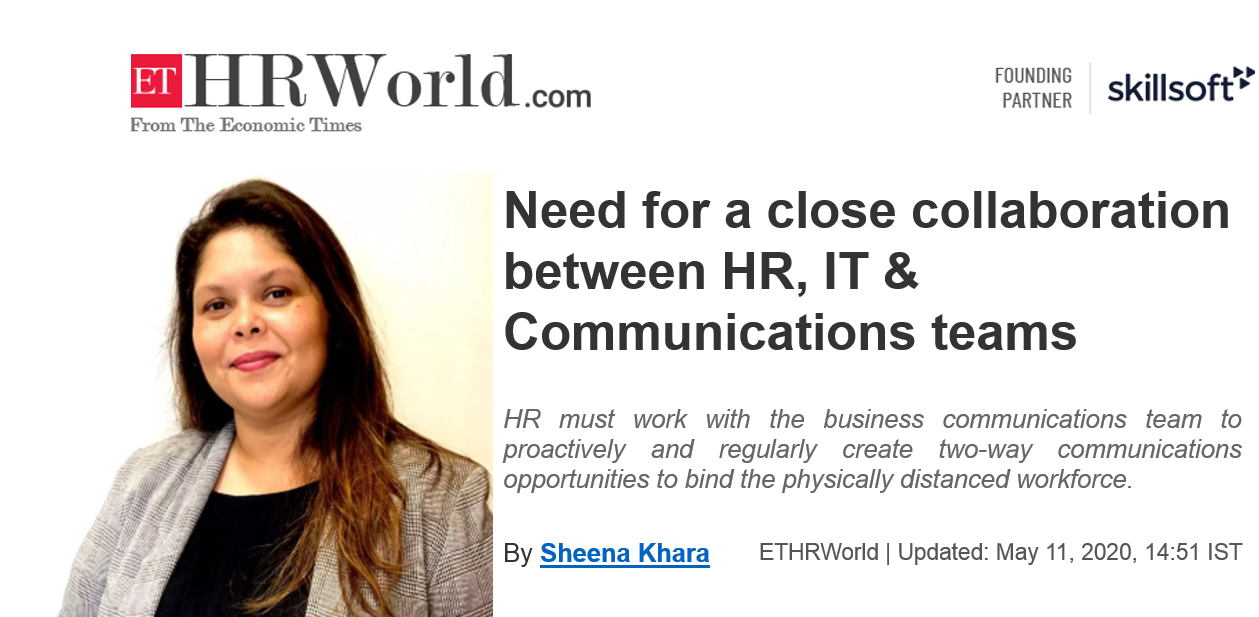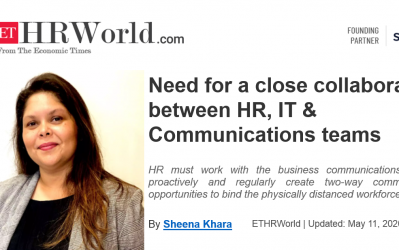
“Great things in business are never done by one person. They’re done by a team of people.” — Steve Jobs
This is so true and even more relevant in the unprecedented situation that we face today, where social distancing has made teamwork and communication the lifeline to keep businesses in business. Consequently, the role of HR is morphing to bridge the new divides being thrown up. In order to do great things, Corporate HR must team up with the Business Communications and Technology teams. They must come together to create winning teams that are strong and resilient even in the most challenging business environment.
The current situation requires us to stay at home and stay safe, leaving ‘Work From Home’ (WFH) the only viable option. A physical workspace naturally binds all. But binding a remotely working workforce requires altogether a different strategy – a strategy which involves Corporate HR to collaborate closely with the Communications and Tech teams of the organization to put into action some creative and innovative initiatives that achieve the following three end results:
• Keep the trust barometer high between the distanced employer and employees
• Deploy effective communications tools for deep employee engagement
• Create a virtual office environment using state-of-the-art hardware and software solutions
At this point, I recall a very popular team building activity wherein each team member is blindfolded turn-by-turn and asked to do a free fall with the trust that someone from the team will catch them. Let us try and understand the above three listed end results through this specific activity.
The blindfolded team member will only take the fall if he has an inherent trust that his team will not let him down. Without this trust, this activity would fail. Similar is the role of Trust in a corporate environment. Building trust and confidence is a two-way process. HR, team leaders and the C-suite must have faith that their employees are not cheating on time and are putting in sincere efforts to deliver what is expected of them. WFH is not a bed of roses and on top of it if there is micromanagement and over scrutiny, employees will become disgruntled and agitated.
At the same time, employees must play their part and exhibit that they are dependable and responsible. HR, in coordination with IT and Communications, must instil a sense of security and confidence in this relationship between team and team leaders through educative videos, case studies, helplines, counselling sessions and so on. The key is to simply keep ears to the ground and ensure that trust levels are high between the siloed workforces.
Once there is an environment of trust created, a deeper employee engagement plan must kick in through effective communications. Let’s come back to the team activity – a team member is blind folded, and his team is standing BEHIND him to catch him, but he takes a leap FORWARD instead! Clearly, the lack of proper communication leading to a complete disaster. This brings us to the importance of clear and effective communications in this whole scenario of WFH.
HR must work with the business communications team to proactively and regularly create two-way communications opportunities to bind the physically distanced workforce. The scattered employees can be bonded with virtual communications tools like e-Newsletters, Social Media, digital PR, online interactive games & social gatherings and so on. Such well-structured and thought through communication channels build a virtual community feeling, help keep the morale high, instil a sense of belonging, and send out various positive messages from time to time.
Now coming to the last point through the team activity again – say we have trust and we have clear communications, but the team that is supposed to support the falling team member is not strong enough or too few in numbers, this task would again collapse. Such a weak link in the chain brings us to the importance of having a robust and reliable support infrastructure that is capable of handling the situation. In a WFH scenario, that support infrastructure is the technology infrastructure which can make or break the entire ecosystem of remote working.
To keep the productivity high and to keep the workforce connected, HR, in partnership with the tech team, should ensure that the scattered workforce has all the basic IT infrastructure required along with new and innovative technological tools. Some of these could be reliable video calling facilities, online meeting platforms, connected screens, sophisticated wireless devices and so on.
Most of us would have read a famous short story – Rip Van Winkle, written by an American author, Washington Irving in which this villager falls asleep and wakes up after 20 years only to find a totally changed world. What Washington Irving visualized through Winkle’s eyes in 1819, Covid 2019 has catapulted us to a new vision of our world with significant shifts in the way we live and work. This changed world will see an increase in the usage of robots with newer opportunities for automation and Artificial Intelligence. This will also be a world with an accelerated adaptation of concepts like hot desking, digital workspaces and heightened digital collaborations between departments, especially HR, Communications & IT.
————-<><><>—————-
Author: Sheena Khara is a Chief Digital Officer of iE3 Innovations Pvt. Limited, a technology firm.
Published on:


